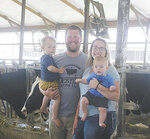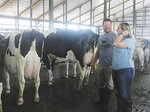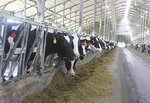Matthew and Brittany Schueller
Destiny Farms LLC
Marshfield, Wisconsin
1,100 cows
Describe your facilities and list your breeding management team. We have seven freestall pens with headlocks with 140-190 cows per pen. Cows are at a 120%-150% stocking density. We separate cows into certain pens depending on their age, mobility and volume of milk they make. Every day, we have an A.I. technician identify which cows are in heat from our activity monitoring system, and he will set the headlocks in that specific pen and breed those cows in heat.
What is your current pregnancy rate? It is at 30%.
What is your reproduction program? Do you use a synchronization program? How do you get animals pregnant? Every cow gets enrolled into a double ovsynch program. They first get bred between 78 to 84 days in milk. We do not cherry-pick any cows before they go through our double ovsynch program, besides the evening before timed A.I. A week before the first pregnancy check, they receive a GnRH shot in case they are open the following week. The idea is that if they are open, we save a week of getting their cycle ready for breeding again. However, if they are pregnant anyway, the GnRH shot does not affect them at all. If they are open at the 29- to 35-day pregnancy check, our veterinarian checks with an ultrasound to verify their corpus luteum is ready for Lutalyse and therefore will be ready to breed that week. We also monitor heats with a system. If someone comes into heat after the first service, they will get bred again off our heat detection systems. No cows are allowed to be bred more than two times in a row based off our monitoring system. We do a three-day shot schedule: Monday at 5 a.m., Lutalyse; Tuesday at 5 a.m., Lutalyse; Wednesday afternoon, GnRH; and Thursday morning, breed. We do all A.I.
Describe your breeding philosophy. We have learned that a proper transition into a cow’s lactation, with no lameness events or health events, along with cow comfort and a strict reproductive shot program is the recipe for success.
What guidelines do you follow to reach the goals for your breeding program? Our breeding program starts before the cow even freshens. So, our first goal is to make sure they transition correctly. After that, we want them to transfer out of our fresh pen – around 10 to 15 days for cows and 20 to 30 days for heifers – to go to their appropriate pen for the rest of their lactation. We schedule a maintenance hoof trim for each cow at least twice in their lactation but also send them through the hoof trimming chute whenever there is a lame event. If we can keep the cow calm, happy and milking well without a lame event or health event, then we start our reproductive program. The crucial part is shot compliance and completion. We have seen the most success on cows that are successful in all of the above.
What are the top traits you look for in breeding your dairy herd, and how has this changed since you started farming? Ron does a diligent job of searching for bulls from all different companies. He has 50 years of experience that helps him pick which characteristics work for our herd. We do enjoy using promising young bulls; however, we mostly choose proven bulls. We’ve found that correct feet and legs and high udders are the two main features that give cows longevity in our herd.
What are certain traits you try to avoid? Straight legs are not ideal for cows walking long distances to the parlor and around the freestall.
Describe the ideal cow for your herd. I would say we find our ideal cows in the older lactation pens. Cows that have correct feet and legs, good suspensory and udder cleft ligaments, wide and deep bodies and a moderate height. These seem to be the type that last the longest in our herd and therefore are the more profitable.
What role does genetics have in reaching the goals of your farm? Genetics have a huge role in reaching our farm’s goals for the future because we are creating the future. We want to use new technology and traits to continue to better the cows we have.
What percentage of your herd is bred to sexed, conventional and beef semen? Heifers: 35% sexed, 35% conventional and 30% beef. Cows: 10% sexed, 40% conventional and 50% beef. We have done just a few flushes in our herd but hope to do more in the future.
What is your conception rate? How does this differ with different types of semen? We have successfully maintained a 45%-55% conception rate over the past year after working with consultants and making changes to our program. It’s great to see results from our hard work. We haven’t noticed that much of a difference between Holstein and Angus.
What is the greatest lesson you have learned through your breeding program? Consistency is key.
What is the age of your heifers at first service? 14 months.
How does your heifer inventory affect your breeding program? We have learned through the past few years that we need to have about 30 heifers coming in a month for replacements. We don’t raise more than that because raising heifers is costly. We have different managerial views; some believe heifers are the newer genetics and have more potential, and the others believe the older cows have proven themselves and have more potential.
Tell us about your farm. Matthew and I farm with his parents, Ron and Lori, on our 1,100-cow dairy farm in central Wisconsin. Ron started the farm in 1970 with just nine cows, and with hard work and determination, he grew and expanded to the farm size we have today. We have around 15 employees plus ourselves who keep our operation running 24/7. We raise calves until they are 6 months old, and then we send them to Nebraska until they are two months out from calving. Then they return home before calving and enter the herd after calving. Once they enter the herd, they don’t leave until they have a career change. We work very closely with our veterinarians, nutritionist and other consultants to have the most effective protocols in place for our cows. We are fortunate to have great employees who continue to help us reach our goals time and time again. Matthew and I are so thankful to Ron and Lori for continuing to set us up for success with their experience and leadership.



Comments
No comments on this item Please log in to comment by clicking here